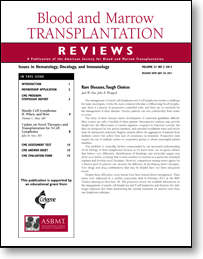
Rare Diseases, Tough Choices
by Jack W. Hsu and John R. Wingard
The management of mantle cell lymphoma and T-cell lymphoma remains a challenge for many oncologists. Unlike the more common follicular or diffuse-large B-cell lymphomas, there is a paucity of prospective controlled trials, and there are no standards for the management of these diseases. Practice patterns can vary considerably from center to center.
The rarity of these diseases makes development of consensus guidelines difficult. Most centers see only a handful of these patients. Retrospective analyses may provide insight into the effectiveness of current regimens compared to historical controls, but they are hampered by low patient numbers, and extended enrollment times and results must be interpreted cautiously. Registry analysis allows the aggregation of patients from multiple centers but suffers from lack of consistency in treatment. Prospective trials require the use of multiple centers or cooperative groups to obtain meaningful patient numbers.
This problem is, ironically, further compounded by our increased understanding of the biology of these lymphomas because as we learn more, we recognize subsets that behave very differently. Identification of histologic and molecular targets may allow us to define a subtype that is more sensitive or resistant to a particular treatment regimen and develop novel therapies. However, competition among newer agents for a limited pool of patients can increase the difficulty of developing newer therapies. New drugs and drug combinations that may be helpful have not been adequately tested.
Despite these difficulties, some lessons have been learned about management. These issues were addressed in a satellite symposium held in February 2011 at the BMT Tandem meeting in Honolulu, HI. The presenters review the available information on the management of mantle cell lymphoma and T-cell lymphoma and illustrate the challenges clinicians face when determining the optimal treatment for patients with these rare lymphoma subtypes.
